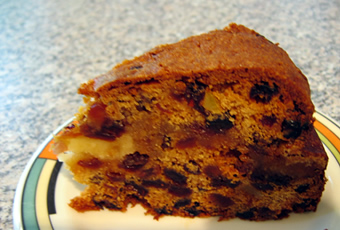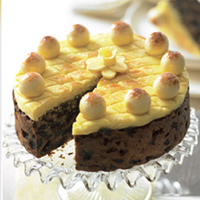« May Day | Main | Dig for Victory »
Sunday May 3, 2009
Unseasonal Cake
When we went to France at Easter, Sheila (G's Mother) gave us a cake to take with us. It was a Simnel cake, and was so delicious, that I decided to try my hand at an unseasonal cake for this weekend. Sheila had "not bothered" with the traditional marzipan topping (which suits me as I am not mad on marzipan) but the layer baked inside was ... mmmmm..... wonderful. So I copied her example.

My picture is of a slice of the cake, as I had a slight disaster after taking it out of the oven. I cooked it yesterday afternoon before we went to the theatre. We were so anxious to eat it that I took it straight out of the tin while it was still hot. [Not for me those silly instructions about "letting it cool fully in the tin" - o no...].
It fell apart. I then had to lassoo it back together with the tin, and let it cool, so it ended up maintaining some kind of round cake shape.
Simnel cakes seem to be made around Easter, but I had some vague memory of their being associated with Mothering Sunday in the UK - and it turns out I am not mistaken. I remember, as a little girl, that when we left church on Mothering Sunday morning, we each took a piece of fruit cake from a large tray of the same handed out by (and presumably baked by) a nice lady from the Mothers Union. We took these home to our grateful Mothers - or not. My Mother hated marzipan so the cake was always eaten by my Father (who loved it). [So our consumption of this cake has never been very traditional!]
The date of Mothering Sunday in the UK is set by the church calendar and is the middle Sunday in Lent (half way between Shrove Tuesday and Good Friday). Since my childhood, I had forgotten this, thinking all such days were invented by Hallmark Cards, even though UK Mother's Day is never the same day as in the US. The origin of the day was to do with attendance on that Sunday at the "Mother" church or the Cathedral of the diocese, and employers would send a rich fruit cake home to their servant girls' Mothers, as a charitable gift.
The name Simnel probably derives from the type of flour used but for a far more interesting set of suggestions, and an altogether more humorous entry than this one, read Raspberry Debacle.
[I especially like the explanation of the origin of marzipan which was "invented when Zeppo Marx fell into a giant pan of almonds just after he'd been for a swim in a pool that was unexpectedly filled with sugar, at which he was so angry that he broke eggs all over himself and rolled around until he was covered in a thick white paste; it certainly tastes like it." Also the author shares my view that it's nicer without the marzipan topping. A shame this blog is now archived.]
Simnel Cake
Ingredients:
- 6 oz (175 g) castor sugar (I like the 'golden' variety)
- 6 oz (175 g) unsalted butter, well softened
- 3 large eggs
- grated zest 1 unwaxed lemon
- 8 oz (225 g) plain flour sifted with 1½ rounded teaspoon of baking powder
- 1 rounded teaspoon mixed spice, or,
½ teaspoon of ground cinammon, ¼ teaspoon of ground ginger, and, ¼ teaspoon of nutmeg - 2oz ground almonds
- 4oz (100g) glace cherries chopped small
- 16oz (450g) mixed dried fruit
- 2 tablespoons milk
- 200g Marzipan
Method
- Preheat the oven to 150 degrees C, or Gas Mark 2. Use butter to grease an 8 inch loose-bottomed or springform cake tin and line with baking parchment.
- Mix together the sifted flour, baking powder, and spices.
- Roll out the 200g marzipan to a circle slightly smaller than your tin size. Use icing sugar to prevent sticking while rolling.
- Beat together the softened butter and sugar, until light and fluffy. (Use an electric whisk if possible as it makes it much easier to do this).
- Beat in the eggs one at a time, adding a little of the flour with each one to avoid curdling.
- Fold in the sifted flour mixture, followed by the ground almonds.
- Mix in the milk, dried fruit, cherries, and lemon zest.
- Spread half of the mixture in the bottom of the tin, and make the surface level with a spatula. Place your circle of marzipan on top.
- Finally spread the remaining mixture over the marzipan.
- Now put it into the oven, and bake for about 2½ to 2¾ hours. Check towards the end of the cooking time to make sure the cake is not going too brown on the top, (if it is, you can cover lightly with a circle of foil for the remainder of the cooking time). The centre should feel firm and springy when lightly pressed.**
When it is cooked, leave it to cool in the tin for at least 30 minutes before turning it out on to a wire rack to cool. - Eat.
** I confess to having some difficulty knowing when the cake is cooked, as, with the skewer test, it never seems to come out clean due to the layer of gooey marzipan in the cake; if you leave it to cook too long, the sides and base of the cake can burn slightly. You can try insulating your cake by wrapping the outside with a layer of brown paper and string, as suggested by Nigella, or you can put greaseproof paper over the top, as suggested by Delia.
And in the end all this depends on how fierce your oven is, and whether or not it's a fan oven - you need to get to know your oven with a test cake.... or several....
Decoration:
It is a shame to leave off the decoration, as that's where you get the religious references - 11 marzipan balls representing the 11 true apostles, or less traditional egg shapes.
To make the topping you need about 300g more of marzipan, and apricot jam. Roll out and cut a circle of marzipan to fit the top of the cake, (use a dusting of icing to stop it sticking), and make your 'apostles' from the remainder. Brush the top of the cake with melted jam, put on the marzipan circle, and stick on your apostles (you may need egg white to make them stick firmly).

Nice traditional decoration on a cake from Tesco, [£7.99].
Note that the 11th apostle has been consumed....
Other (different) recipes, and pretty pictures of decorations appear at Delicious Magazine, Mary Berry at the BBC, and Delia Online. Raspberry Debacle (website sadly disappeared), chose to add faces to his apostles, and explains how he tried to like marzipan, using a preparation method which relied on the subsequent effect of Stockhausen Syndrome - but failed.
Posted by Christina at 10:26 AM. Category: Kitchen and food
